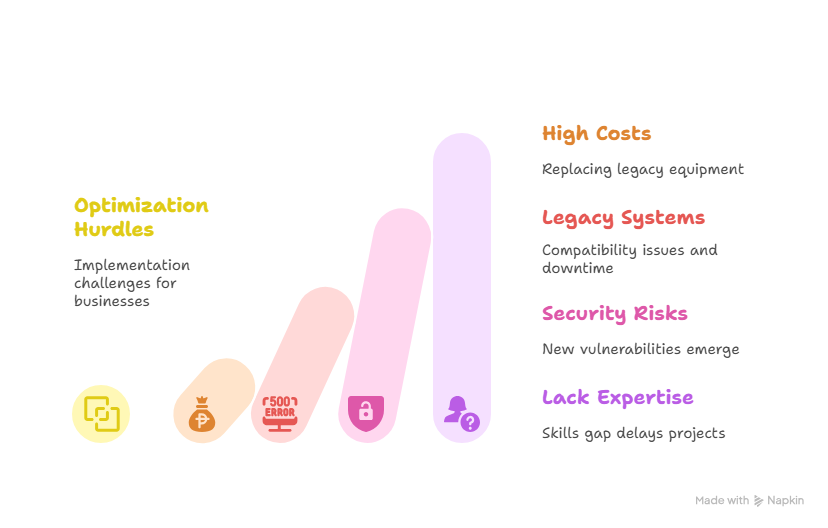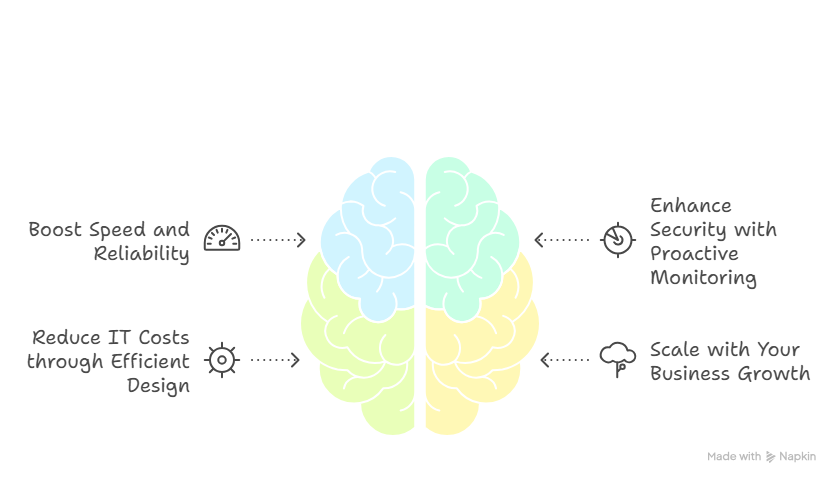In today’s digital-first economy, the strength of a business is often determined by the strength of its network. Network optimization involves improving an organization’s network infrastructure to boost its performance, speed, security, and overall efficiency. Put simply, it’s the fine-tuning that ensures every connection, device, and data packet moves seamlessly without bottlenecks.
Why is this important? As companies can’t risk operating with slow or unstable networks anymore. Customers expect instant access, employees depend on cloud-based tools, and cybersecurity threats are more sophisticated than ever. Without proper network optimization, companies face reduced productivity, higher costs, and lost opportunities.
When approached strategically, optimization not only cuts costs but also scales with future growth—turning a basic IT necessity into a genuine competitive advantage.
At Elysian Communication, we help organizations design and optimize their network architecture for maximum efficiency, ensuring they stay ahead in today’s fast-paced world.
What is Network Optimization?
At its core, network optimization is the process of analyzing, configuring, and upgrading a network to maximize its performance while minimizing operational costs. Think of it as tuning an engine—removing inefficiencies, reducing lag, and ensuring the system runs smoothly.
Role in Network Architecture Optimization
While network optimization focuses on enhancing performance, it directly complements network architecture optimization, which looks at the broader design of how systems, devices, and data flows are structured. Together, these practices ensure both the “blueprint” and the “performance” of a network are future-proof.
Practical Examples of Network Optimization and How They Help Businesses
1. Reducing Latency
- Example: Implementing caching or routing improvements for faster access.
- Business Impact: Lower latency means employees and customers experience quicker response times. For a business, this translates into faster transactions, smoother video calls, and more efficient collaboration. For sectors such as online retail and financial services, even the smallest delay in response time can impact customer experience and lead to lost revenue opportunities.
2. Improving Bandwidth Utilization
- Example: Prioritizing mission-critical applications over background processes.
- Business Impact: By ensuring essential applications like ERP systems, CRMs, or VoIP calls get priority, businesses reduce slowdowns during peak hours. This avoids wasted time and keeps productivity high while lowering frustration for staff and clients. It also reduces the need for expensive bandwidth upgrades, saving costs.
3. Increasing Uptime
- For instance, analyzing network activity to identify possible issues in advance and prevent disruptions.
- Business Consequences: IT outages are expensive—studies indicate that enterprises lose an average of $5,600 for every minute of network downtime. Proactive monitoring minimizes outages, keeps services accessible to customers, and prevents lost sales opportunities. Consistent uptime also builds trust with clients and protects brand reputation.
In short, network optimization helps businesses run faster, smarter, and safer, driving both operational efficiency and customer satisfaction.
Why Network Optimization is Essential for Modern Businesses
Modern organizations face digital pressures that make network optimization a necessity, not a luxury.
Rising Demand for Data-Driven Operations
From real-time analytics to AI-driven tools, companies rely heavily on uninterrupted access to data. Even a few seconds of delay can impact decision-making, customer satisfaction, and revenue.
Cybersecurity Implications
Networks that aren’t properly optimized are at a higher risk of security breaches. Optimization often involves stronger monitoring systems and enhanced visibility into traffic—closing gaps that cybercriminals could exploit.
Cloud Adoption and Remote Workforce Needs
With hybrid and remote work models becoming the norm, employees must securely connect to cloud-based applications from anywhere. Optimizing the network ensures that speed and security aren’t compromised.
Key Benefits of Network Optimization

Investing in network optimization delivers measurable returns for organizations of all sizes. Beyond technical improvements, it creates real business value:
1. Faster Performance
When latency is reduced and throughput increases, employees experience smoother workflows and applications respond instantly. This keeps teams productive, shortens project timelines, and provides customers with a faster, more reliable service. For example, a financial services company can process transactions faster, while an e-commerce site ensures shoppers enjoy a seamless checkout experience.
2. Improved Reliability
Unexpected service outages rank among the most expensive problems organizations encounter. With network optimization, monitoring systems detect bottlenecks and potential failures early, preventing disruptions before they happen. A reliable network means employees spend less time troubleshooting, and customers always have access to your products and services, reinforcing trust and brand loyalty.
3. Lower IT Costs
Optimized networks maximize the use of existing resources. By eliminating wasted bandwidth, balancing loads, and reducing energy consumption, companies spend less on infrastructure expansion and emergency repairs. Instead of continually purchasing new hardware, businesses extend the lifespan of their current systems—leading to significant savings over time.
4. Enhanced Security
Today’s networks face constant cyber threats. Optimization integrates advanced monitoring, better traffic visibility, and proactive defenses that reduce vulnerabilities. By strengthening security at the network level, businesses protect sensitive data, maintain compliance with regulations, and avoid the financial and reputational costs of breaches.
Quick Insight: According to Gartner, businesses that invest in proactive network optimization can reduce IT operational costs by up to 30% while improving overall performance.
This section positions network optimization not just as a technical upgrade, but as a strategic investment in productivity, cost savings, and long-term resilience.
5. Application Speed
Applications run faster and more reliably, enabling teams to complete tasks efficiently while providing customers with a smooth, seamless digital experience.
6. Downtime Hours per Month
Downtime is reduced to just 2–4 hours monthly, ensuring uninterrupted operations, consistent service availability, and stronger customer trust.
7. IT Infrastructure Costs
Businesses lower IT expenses by around 25% through efficient resource utilization, extended hardware lifespan, and reduced energy consumption.
8. Security Incidents
Fewer security threats and breaches occur, thanks to advanced monitoring and traffic visibility, protecting sensitive data and maintaining compliance.
In short, network optimization drives speed, reliability, cost efficiency, and security—all critical factors for sustainable business growth.
Top Network Optimization Techniques
To unlock the full potential of their IT infrastructure, businesses can apply several proven network optimization techniques:
1. Bandwidth Management
By allocating network resources to mission-critical applications, organizations prevent congestion and ensure essential tasks run smoothly. For example, prioritizing video conferencing over background software updates helps employees stay productive without interruptions.
2. WAN Optimization
Wide-area networks (WANs) often struggle with latency due to large distances and high traffic volumes. WAN optimization uses techniques like data compression, caching, and deduplication to speed up connections, making cloud applications and remote access more efficient.
3. Load Balancing
Traffic surges can overwhelm a single server, causing delays or outages. Load balancing distributes incoming requests across multiple servers, improving both speed and reliability. This is especially valuable for e-commerce platforms, SaaS providers, or any business with high customer traffic.
4. Network Monitoring & Analytics
Live monitoring solutions capture key performance indicators like response delays, data throughput, and system error frequencies. Analytics then provide insights to proactively detect issues before they impact operations. Continuous monitoring also strengthens security by identifying unusual traffic patterns.
5. SD-WAN Deployment
Software-Defined WAN (SD-WAN) is a modern solution that improves flexibility, security, and cost efficiency. It allows businesses to route traffic intelligently across multiple connection types (like broadband and MPLS), ensuring faster, safer, and more cost-effective network performance.
Common Challenges in Network Optimization

While the benefits of network optimization are clear, businesses often face hurdles in implementation:
1. High Infrastructure Costs
Replacing legacy equipment such as routers, firewalls, and other hardware often demands a considerable financial outlay. Without a clear roadmap, costs may spiral, making businesses hesitant to commit.
2. Legacy Systems
Older equipment or software may not support modern optimization tools, leading to compatibility issues. Businesses relying heavily on legacy systems often face higher risks of bottlenecks and downtime.
3. Security Risks
If optimization efforts lack proper oversight, new vulnerabilities can emerge. For example, increased data compression or third-party integrations may expose weaknesses if security protocols aren’t updated simultaneously.
4. Lack of Expertise
Many organizations lack in-house specialists who understand advanced optimization tools such as SD-WAN or WAN accelerators. This skills gap often delays projects and can prevent businesses from realizing the full benefits of optimization.
While these challenges can be significant, partnering with experts like Elysian Communication ensures businesses receive tailored strategies that balance performance improvements with cost efficiency and security.
Checklist for Successful Network Optimization
For IT leaders and decision-makers, successful network optimization starts with a clear, structured approach. Here’s a practical checklist to guide you:
1. Assess Current Network Performance
Run a full audit of your existing infrastructure. Measure latency, downtime, bandwidth utilization, and application performance to establish a baseline.
2. Identify Recurring Bottlenecks
Pinpoint weak spots such as overloaded servers, outdated firewalls, or inefficient routing paths. Addressing these bottlenecks early helps avoid recurring issues.
3. Implement Advanced Monitoring Tools
Use continuous monitoring and data analytics to better understand and oversee network traffic flows. Proactive alerts help IT teams resolve problems before they disrupt operations.
4. Regularly Update Hardware and Software
Aging equipment and outdated software often limit performance. Routine updates and upgrades extend system reliability while improving security posture.
5. Partner with Trusted Network Optimization Experts
Not every business has the in-house expertise to manage complex optimization processes like SD-WAN deployment or WAN acceleration. Working with specialists ensures you get the right strategy for your business needs.
Remember, network optimization should be a continuous effort rather than a single, one-off task Continuous reviews ensure your network scales with business growth.
Why Partner with Elysian Communication for Network Optimization

While internal teams can handle basic improvements, unlocking the full potential of network optimization often requires expert guidance. That’s where Elysian Communication makes the difference.
At Elysian Communication, we design and implement network architecture optimization strategies tailored to your unique environment. Our approach ensures your business is not only running faster but also running smarter.
Here’s what sets us apart:
- Boost Speed and Reliability: Through intelligent bandwidth management, load balancing, and modern tools like SD-WAN, we ensure your business applications are always responsive and available.
- Enhance Security with Proactive Monitoring: Advanced analytics and real-time monitoring keep threats in check, giving you stronger compliance and reduced risk.
- Reduce IT Costs through Efficient Design: By eliminating waste and optimizing existing infrastructure, we help you lower operational costs while extending hardware lifespan.
- Scale with Your Business Growth: As your operations expand, our solutions adapt—ensuring performance and security stay consistent no matter how complex your network becomes.
Looking to elevate your business? Discover customized solutions with Elysian Communication today.
Frequently Asked Questions
1: What is the primary objective of optimizing a network?
The primary goal is to maximize speed, reliability, and security while minimizing operational costs. It ensures networks support business growth without unnecessary inefficiencies.
2: How often should businesses optimize their network?
A performance review every 6–12 months is recommended. Regular optimization keeps the network efficient, secure, and capable of handling new technologies and workloads.
3: Is network optimization expensive?
Although it requires an upfront investment, the long-term advantages significantly surpass the initial expense. Businesses typically save through reduced downtime, lower infrastructure expenses, and improved productivity.
4: Can small businesses benefit from it?
Absolutely. Even small organizations can see significant improvements in performance, reduced IT costs, and enhanced security. Optimization helps smaller teams operate more competitively.
Conclusion
In an era where downtime translates directly into lost opportunities, network optimization is no longer optional—it is a core business strategy. From improving application performance to strengthening cybersecurity, optimization ensures that networks can keep pace with modern business demands.
Whether you operate as a small enterprise or a large organization, partnering with experienced professionals makes all the difference. A tailored approach ensures that your network is not just faster and more secure, but also cost-efficient and scalable for the future.
Consult Elysian Communication today to design and optimize your network architecture for maximum efficiency, security, and long-term growth.





